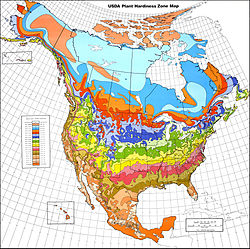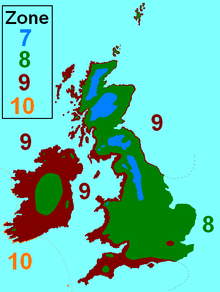Horticulture/USDA Hardiness Zones

A hardiness zone is a geographically-defined zone in which a specific category of plant life is capable of growing, as defined by temperature hardiness, or ability to withstand the minimum temperatures of the zone. The zones were first developed by the United States Department of Agriculture (USDA), and have subsequently been adopted elsewhere. They are categorized according to the mean of the lowest temperature recorded each winter, termed the "average annual minimum temperature". Thus if five successive winters reach respective minima of −14 °C, −12 °C, −8 °C, −16 °C, and −13 °C, the mean coldest temperature is −12.6 °C, placing the site in zone 7.
Benefits and criticisms
[edit | edit source]The hardiness zones are effective in that, for many situations, extremes of winter cold are a major determining factor in whether a plant species can be cultivated outdoors at a particular location. However, it does have a number of drawbacks, most significantly in not incorporating summer heat levels into the zone determination. Thus sites which may have the same mean winter minima, but markedly different summer temperatures, will still be accorded the same hardiness zone. An extreme example is the Shetland Islands and southern Alabama, which are both on the boundary of zones 8 and 9 and share the same winter minima, but very little else in their climates; in summer, the continental climate of Alabama is about 20 degrees Celsius hotter than the oceanic climate of Shetland, and there are very few plants that can be grown at both locations. Due to its maritime climate, the UK is in AHS Heat Zone 2 (having 1 to 8 days hotter than 30 degrees Celsius), whereas Alabama is in Zones 7 to 9 (61 to 150 days hotter than 30 degrees Celsius).
Another problem is that the hardiness zones do not take into account the reliability of the snow cover. Snow acts like an insulator against extreme cold temperatures, protecting the root system of hibernating plants. If the snow cover is reliable (then present during the coldest days), the actual temperature to which the roots are exposed is not as low as the hardiness zone number would indicate. As an example, Quebec City in Canada is located in zone 4 but can rely on an important snow cover every year, making it possible to cultivate plants normally rated for zones 5 or 6, whereas in Montreal, located in zone 5, it is sometimes difficult to cultivate plants adapted to the zone because of the unreliable snow cover.
Low temperature is not the only determinant of plant survival - other factors such as high summer temperature, humidity, soil temperature, etc. may be equally important. Also, many plants will survive in a locality but won't flower if the day length is inappropriate or if they require vernalisation (a particular duration of low temperature). The low temperature statistic is only appropriate for woody perennial species, and even then its use is limited. With annuals the time of planting can often be adjusted to allow growth beyond their normal geographical range.
The main factors determining average minimum temperature are altitude, latitude and proximity to the coast.
- Zone 1 covers the alpine areas of south eastern Australia.
- Zone 2 the tablelands of south east Queensland, New South Wales and Victoria, and the uplands of central Tasmania.
- Zone 3 includes much of the southern half of the continent, except for near the coast.
- Zone 4, because of the warmer seaboard, covers a broad area from coastal Queensland across to Shark Bay and Geraldton in the west, and includes the Mornington Peninsula, areas adjacent to Spencer Gulf and Adelaide, the south western coastal zone, Sydney and the north coast of NSW, along with a number of localities dotted all around the southern coast of the continent.
- Zone 5 covers, some of the Queensland coast, Western Australia north of Shark Bay and across the top end.
- Zone 6 includes the Queensland coast north of Cairns, Cape York Peninsula and the coast of the Northern Territory.
- Zone 7 is mainly restricted to islands off the north coast.
There are problems with maps of this type: the spread of weather stations is insufficient to give clear zones and too many places with different climates are lumped together. Only 738 Australian stations have records of more than ten years (one station per 98,491 hectares!), though more populated areas have relatively fewer hectares per station. Local factors such as aspect, altitude, proximity to the sea also complicate the matter. For example, Mt Isa has three climatic stations with more than a ten year record. One is in Zone 4a, one in Zone 4b and the other is in Zone 5a. Likewise Sydney residents can choose between Zones 3a to 4b. Most other cities have similar problems. Different locations in the same city are suitable for different plants making it hard to draw a meaningful map. There may even be a case for publishing a list of weather stations and their zone Classification to allow best use of local conditions.
The map is thus only useful as a broad guide. It needs interpretation that takes into account factors other than low temperature, as well as local knowledge.
An alternative system for describing plant hardiness is to use indicator plants (the USDA also publishes a list of these to go with their map). Common plants with known limits to their range are used. For example, many people will know whether lemons will grow in their locality. If you then say Geraldton Wax will grow more or less where lemons will grow you have defined the range of Geraldton Wax with some accuracy (whether or not it will flower is another problem). Unfortunately no two plant species have exactly the same requirements and there are even within-species differences. 'Meyer' lemons, for example, are more cold tolerant than 'Eureka'. You can really only define core areas and they are often fairly arbitrary.
North American hardiness zones
[edit | edit source]
In North America hardiness zones map was revised and published by the USDA in 1990 and can be used as a guideline for categorizing locations suitable for growing a particular annual plant variety.
The temperatures are based on the lowest temperatures recorded for each of the years 1974 to 1986 in the United States and Canada and 1971 to 1984 in Mexico. The map shows 10 different zones, each of which represents an area of winter hardiness for the plants of agriculture and our natural landscape. A draft of the latest version also introduces zone 11 to represent areas that have average annual minimum temperatures above 40°F (4.4°C) and that are therefore essentially frost free.
United Kingdom and Ireland Hardiness Zones
[edit | edit source]
Due to the moderating effect of the Gulf Stream on the Irish and UK's temperate maritime climate, the UK, and Ireland even more so, have rather milder winters than their northerly position suggests. This means that the hardiness zones relevant to the UK are quite high, from 7 to 10, as shown below.
- 7. In Scotland the Grampians, Highlands and locally in the Southern Uplands and in England the Pennines.
- 8. Most of England, Wales and Scotland, and parts of central Ireland.
- 9. Most of western and southern England and Wales, western Scotland, also a very narrow coastal fringe on the east coast of Scotland and northeast England (within 5 km of the North Sea), London, and most of Ireland.
- 10. Very low lying coastal areas of the southwest of Ireland, and the Isles of Scilly.
Asia-Pacific Hardiness Zones
[edit | edit source]The Australia Continent, though surrounded by ocean, is drier than Europe or North America. Australia numbers its climate zones differently, but this system can be translated into the North American systems with minimal effort. Plant hardiness refers to survivability of the conditions of a particular location, including heat tolerance, soil moisture, humidity and so on. This map is based only on how well they survive low winter temperatures; a gross oversimplification. For example, are plants affected more by a single extremely low temperature night, or is the number of days of frost (the duration of winter) more important? In fact both are important, but the statistic for the map only relates directly to the former. Moreover, plants will survive in an area for some time, but a rare catastrophic cold snap will kill them. Some risk evaluation - the probability of getting a particularly severe low temperature - often would be more useful rather than just the average conditions.
Updates
[edit | edit source]In 2003, a preliminary draft of a new map was produced by the American Horticultural Society (AHS), compiled by Meteorological Evaluation Services Co., Inc. of Amityville, NY, using temperature data collected from July 1986 to March 2002. This was a period of unusually warm winters, especially in the eastern U.S.A., and thus the 2003 map places many areas a zone higher (warmer) than the 1990 map. The draft map also shows finer detail, for example reflecting urban heat islands by showing the downtown areas of several cities (e.g., Baltimore, Maryland and Washington, DC) as a full zone warmer than outlying areas. The 2003 draft map has been widely criticized and its current status is uncertain; as of April 2006 the AHS website still presents the 1990 map as the current one.
In addition, the National Arbor Day Foundation has recently completed an extensive updating of U.S. Hardiness Zones in 2004. The new 2004 Arborday.org Hardiness Zones map is based on the most recent 15 year’s data available from more than 5,000 National Climatic Data Center cooperative stations across the United States.
Once the Foundation analyzed the new data, hardiness zones were revised, generally reflecting warmer recent temperatures in many parts of the country. The Arbor Day Foundation used the updated versions of the same sources of data as had been utilized by the U.S. Department of Agriculture in the creation of its hardiness zone maps. The 2004 map appears to validate the data used in the 2003 draft completed by the AHS. http://www.arborday.org/media/zones.cfm
U.S. Cities
[edit | edit source]Here are the USDA plant hardiness zones for major U.S. cities (based on the draft 2003 map):
| City | Zone | City | Zone |
|---|---|---|---|
| Albuquerque, New Mexico | 7 | Oklahoma City, Oklahoma | 7 |
| Anchorage, Alaska | 4 | Omaha, Nebraska | 5 |
| Atlanta, Georgia | 8 | Orlando, Florida | 10 |
| Baltimore, Maryland | 8 (in part) | Philadelphia, Pennsylvania | 7 |
| Boston, Massachusetts | 7 (in part) | Phoenix, Arizona | 9 |
| Chicago, Illinois | 5-6 | Pittsburgh, Pennsylvania | 6 |
| Cincinnati, Ohio | 7 | Dallas, Texas | 8 |
| Portland, Oregon | 9 | Denver, Colorado | 5 |
| St. Louis, Missouri | 6 | Detroit, Michigan | 5-6 |
| Salt Lake City, Utah | 7 | Honolulu, Hawaii | 11 |
| San Antonio, Texas | 9 | Houston, Texas | 9 |
| San Diego, California | 10 | Las Vegas, Nevada | 9 |
| San Francisco, California | 10 | Los Angeles, California | 10 |
| Seattle, Washington | 8 | Memphis, Tennessee | 8 |
| Tampa, Florida | 10 | Miami, Florida | 11 |
| Tucson, Arizona | 8 | Minneapolis, Minnesota | 5 |
| Tulsa, Oklahoma | 7 | Nashville, Tennessee | 7 |
| Washington, D.C. | 8 (in part) | New Orleans, Louisiana | 9 |
| Wichita, Kansas | 6 | New York, New York | 7 |
| Raleigh, North Carolina | 8 |